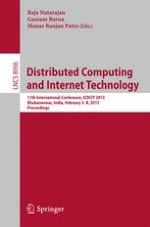2015 | Buch
Distributed Computing and Internet Technology
11th International Conference, ICDCIT 2015, Bhubaneswar, India, February 5-8, 2015. Proceedings
herausgegeben von: Raja Natarajan, Gautam Barua, Manas Ranjan Patra
Verlag: Springer International Publishing
Buchreihe : Lecture Notes in Computer Science
